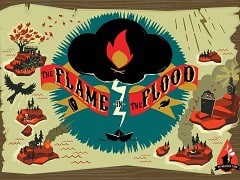You can trust VideoGamer. Our team of gaming experts spend hours testing and reviewing the latest games, to ensure you're reading the most comprehensive guide possible. Rest assured, all imagery and advice is unique and original. Check out how we test and review games here
The Flame in the Flood is a roguelike survival game, but given that roguelike is, as a term, about as helpful as this review saying ‘I really enjoyed the gameplay’ before self destructing entirely, let’s start again. The Flame in the Flood is an indie game from The Molasses Flood, about a woman and her dog travelling down a huge, wild river (this presumably being the flood) and trying to survive for as long as possible (this presumably being the flame) in the back of beyond of America, after society has collapsed. This America is beautiful, it is desolate, and it will kill you again and again.
The game will draw a lot of (accurate) comparisons to Don’t Starve, both similarly – shudder at the word – charming survival games that will, once you start playing and form the immediate opinion that survival isn’t so hard after all, prove you wrong by shellacking you over the head with increasingly complex systems of crafting food, tools, and clothing, combined with increasing scarcity of resources. And also wolves.
The reason The Flame in the Flood is described as a roguelike is because, again like Don’t Starve, your environment, and the materials you find along the way, are procedurally generated, meaning every game you play will be different. The locations that you scavenge are little islands in the huge river: a campsite, an overgrown farm, an abandoned town. Sometimes you’ll find life-sustaining food. Sometimes not.
The other reason The Flame in the Flood might be described as a roguelike is because death is a permanent state, and once you reach it you have to either reload a checkpoint or start all over again, depending on what difficulty you’re playing at. There are many potential ways for Scout, your determined little avatar, to bite the dust, but you’ll mostly be juggling her most basic needs.
Scout can sleep safely at fires and in abandoned structures like old school buses or farmhouses, but sleeping makes her a little bit more hungry and thirsty. You can drink unfiltered water in a pinch, but that’ll give you parasites unless you can purify it, and food goes much further if you can cook it – but for that you need a fire. You can craft better clothes if you’ve managed to collect the right materials, but that uses up a stitching kit, and you might need that if you get a laceration from a wild animal (and even mild injuries like ant bites swiftly progress to infections and fever).
It should be noted that the complexity inherent in this inventory and crafting system is a bit of an arse. It becomes increasingly fiddly to navigate through everything and remember which things you’ve stored on your raft. It’s a game that requires close examination and experimentation to really get the hang of, which is sadly not an option available to people in a real life or death scenario.
Weighing up your current situation against possible situations and your luck – that flighty bitch – becomes an ongoing process that makes you actually feel a bit like a desperate loner. The survival in The Flame and the Flood is an ever-repeating cycle. You could die at literally any point just because you were unlucky, which is a fantastic way to refresh the concept of a survival game, and stop it from developing into a grind wherein you’re constanting farming for components just to build a slightly nicer wall around your house. You have no house; you must constantly move, and will have no guaranteed access to anything you need. The small victories therefore become incredibly satisfying. Every new day is a success, and making Scout a rabbit skin hat was the best thing ever. For that week, anyway.
Contrasting the unsettling nature of the game is the art design, which is oddly comforting. It’s simplistic and stylised, like illustrations in the bleakest childrens’ book your parents never read to you because they don’t love you, combined with a gentle, acoustic folk music score that lulls you into a simplistic way of thinking befitting a lone wanderer. The whole game feels, at times, as if you’re playing out the great American novel, which must be deliberate. The main character is called Scout, like Harper Lee’s protagonist in To Kill A Mockingbird; she floats down river on a raft like Huck Finn; she carries the flame through the flood just like the metaphorical fire was carried in post-apocalyptic ‘this book totally changed my life’ book The Road. It’s beautiful, but in a sad way, which, as art students in coffee houses will tell you, is the most beautiful kind of beautiful.
You get to have a different survival story every time, in a lovely setting, whilst discovering hints of civilisation in the emptiness – feral children who share arrows with you, the distant radio signal that is your first objective, fires that are lit before you arrived. What’s not to enjoy? Just watch out for the fucking wolves, obviously.
Version Tested: Xbox One
The Flame in the Flood
- Platform(s): macOS, Nintendo Switch, PC, PlayStation 4, Xbox One
- Genre(s): Action, Indie, Simulation







